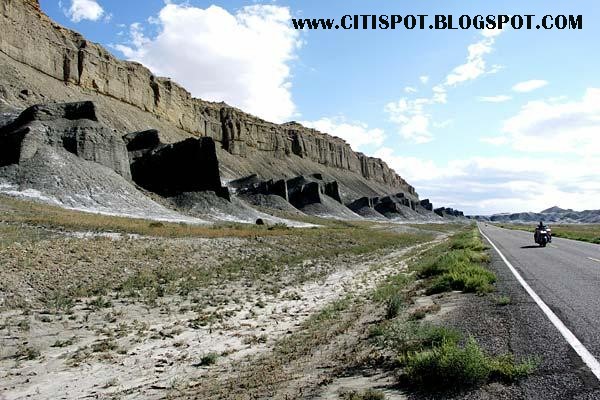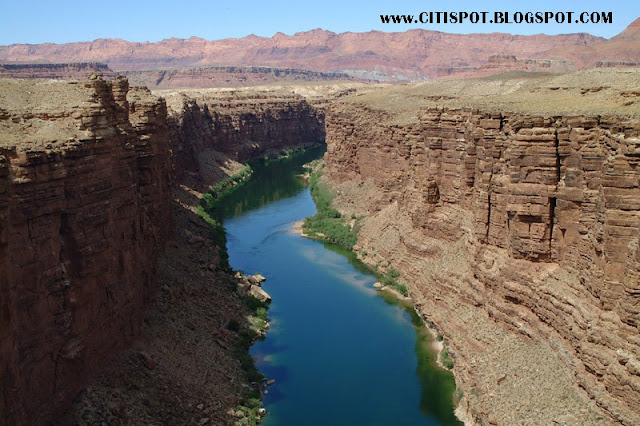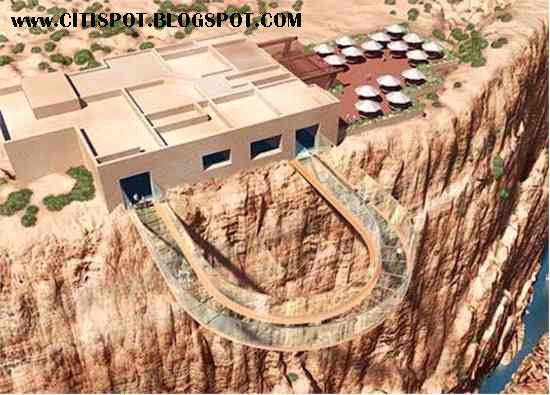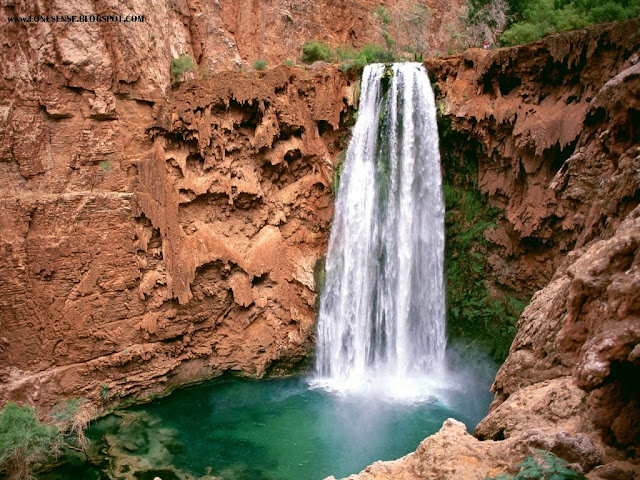The Grand Canyon National Park offers incredible scenery and amazing history to those who visit its rim. Recognized as one of the seven Natural Wonders of the World, the Grand Canyon does not disappoint you in the panoramic view that is incomparable anywhere else in the world.
 While it is not the deepest canyon in the world is be by far the most rich in both scenery and history. The amazing play of color on the rocks will keep you snapping photos. To those who are interested in its geologic content it is well preserved ancient geology that is fully exposed along the walls and offers unique historical information.
While it is not the deepest canyon in the world is be by far the most rich in both scenery and history. The amazing play of color on the rocks will keep you snapping photos. To those who are interested in its geologic content it is well preserved ancient geology that is fully exposed along the walls and offers unique historical information.




 Back To Top
Back To Top
 Until the advent of the civil war, there was very little known about the canyon and it was in fact virtually unknown and certainly unmapped. Major John Powell changed all that in one trip. The Major was a veteran of the war, and had a real desire for adventure, loved science and had, as a result of the war, only one arm.
Until the advent of the civil war, there was very little known about the canyon and it was in fact virtually unknown and certainly unmapped. Major John Powell changed all that in one trip. The Major was a veteran of the war, and had a real desire for adventure, loved science and had, as a result of the war, only one arm.


 Back To Top
Back To Top




 Touring the Grand Canyon
Touring the Grand Canyon


 A much smaller number of people will view the canyon from the north edge, which is only 10 miles directly across from the South Rim. The North Rim rises 1000 feet higher than the South Rim and is much less accessible. Heavy snows close the rim from October to May every year.
A much smaller number of people will view the canyon from the north edge, which is only 10 miles directly across from the South Rim. The North Rim rises 1000 feet higher than the South Rim and is much less accessible. Heavy snows close the rim from October to May every year.



 The Abyss
The Abyss


 Back To Top
Back To Top





 Back To Top
Back To Top
 Grand Canyon National Park is singular in the national parks in that because of its wilderness it has grown into a small town of its own, self sustaining with hotels, gift shops, a post office and a variety of other services available to you while you are visiting the canyon.
Grand Canyon National Park is singular in the national parks in that because of its wilderness it has grown into a small town of its own, self sustaining with hotels, gift shops, a post office and a variety of other services available to you while you are visiting the canyon.





 Back To Top
Back To Top




 Back To Top
Back To Top





 Back To Top
Back To Top




 Back To Top
Back To Top






 Back To Top
Back To Top





 Back To Top
Back To Top




 Back To Top
Back To Top
Related Topic: Nature and Human


The Canyon achieved Federal protection in 1893, when it was termed a Forest Preserve, and again later as a national monument, but not until 1919 did it become a national park. Today the Canyon Park takes in over 5 million tourists every year. When it began as a national park in 1919, the number was about 45,000.







Powell chose nine companions who would go with him and with only four very small boats made of wood; they traversed the Colorado River, through the canyon. Only about half of the men returned from the trip. This group was the first to make the journey through the canyon on the Colorado.








Whatever your reasons for traveling to the Grand Canyon; to spend time hiking deep into the canyons, or to run the rapids of the Colorado River far below; a trip here will have you standing at the canyon rim staring in rapt admiration of the beauty that is exposed to your view.
The Grand Canyon, stretching for over 250 miles along the Colorado River has a wide array of scenic delights, among them the vast geologic history that is exposed to your view by the work of many years of erosion.
Some of the larger animals seen wondering in and around the Grand Canyon include big horn sheep, mule deer, mountain lions, bobcats and coyote. Birds you many see include both Bald and Golden Eagles, several types of hawks including the Red-tailed Hawk, Jays of all types, Mountain Chickadees and Wild Turkeys. Reptiles include many species of lizards and snakes.
Well known for its size and its very intricate and diverse landscape it is also very significant geologically because of the ancient rock layers that are so well preserved and so beautifully exposed to the eye in the walls of the canyon. They present a living history of the continent of North America and are spectacular both in what they afford us historically as well as scenically.
Approximately five million people travel to the canyon each year, and most will see the canyon from the south rim, coming for the scenery and very little more. There is however a great deal more to be seen and done in the Grand Canyon , including Grand Canyon Village, Hermits Rest Road and Desert View Drive. The South Rim, 60 miles north of Williams and 80 miles north of Flagstaff, Arizona, is the most easily accessed part of the park and is open all year.
Back To Top
Back To Top



Even in the best of weather this side, although an incredible viewpoint, is much more difficult to get to, being about 220 miles further by car than the south rim, or by foot, across the canyon, about twenty miles hiking across the South and North Kaibab trail.
The Inner Canyon includes everything below the rim and is seen primarily by die hard hikers, mule riders and river rafters. Many opportunities exist here for adventurous people who live to backpack, ride the mules to the well known Phantom Ranch, or take a rafting trip down the river.
Having supported human life for over 4 thousand years, the canyons are the site of much history of human life a well, and have given up many secrets over the years such as petroglyphs, pottery, dolls and the history of the Anasazi, left behind in over 3500 different locations of throughout the canyon.
Back To Top



With a drop of 3,000 feet to the Tonto Platform, the Abyss is one of the most frequented stops on West Rim Drive. From the Abyss, you’ll be able to see the isolated sandstone columns, the largest of which , the Monument is something that should not be missed.
Bright Angel Lodge
Built of Oregon pine logs and native stone in 1935, Bright Angel Lodge is comprised of rustic cabins set off from the main building. The rocks used in the lodge’s “geologic” fireplace are arranged in the same order in which they are layered in the Grand Canyon.
Bright Angel Trailhead
Starting near Kolb Studio, this trailhead is the starting point for perhaps the best known of all the trails descending to the bottom of the canyon. Originally a bighorn sheep path that was later used by the Havasupai Indians, it was widened late in the 19th century and descends 5,510 feet to the Colorado River. If you plan to traverse the trail for very long, you should have the proper equipment and notify the park representatives at the visitor center.
Desert View and the Watchtower
From the top of the 70 feet stone-and-mortar watchtower, you can see even the distant Painted Desert to the east and the 3,000 feet high Vermilion Cliffs rising from a plateau near the Utah border. The Colorado River too is visible in this nearly 360 degree panorama.
El Tovar Hotel
Built in 1905, this log structure retains nearly all of its early days. If the weather is cool, a stone fireplace will help to warm you. The lobby, a rustic delight is a treasure chest of taxidermy. The back porch provides a beautiful vantage point for viewing the canyon.
Grand Canyon Railway
In 1989 the Grand Canyon Railway re-inaugurated service along a route established in 1901. The trip, which runs over 60 miles in restored cars from Williams Depot to the South Rim takes the train through prairie, ranch and national park land to the log-cabin train station in Grand Canyon Village.
Back To Top









Hiking opportunities range from a leisurely walk on well-defined very difficult trips that will take several days to arrive at the other rim. Park rangers or visitor-center personnel will happily provide you with information about routes. While there this summer, the park rangers were much in evidence and ready to answer any questions we may have had about the geology, trips or where to access certain trails. You will need to plan on spending two to three days if you want to hike the gorge from rim to rim.
There are some very good accommodations for hikers along the way that include the campgrounds at Indian Garden and Bright Angel, or Phantom Ranch. The steep nine mile Hermit Trail beginning at Hermits Rest is recommended for experienced long-distance hikers only.
For much of the year, no water is available along the way; ask a park ranger about the availability of water at Santa Maria Springs and Hermit Creek. The route leads down to the Colorado River and has inspiring views of Hermit Gorge and the Redwall and Supai formations.
Many who have made the rafting trip down the Colorado River through the Grand Canyon say it is the adventure of a lifetime.
Trips embark from Lee’s Ferry, below Glen Canyon Dam near Page, Arizona. If you haven’t had a chance to see the Grand Canyon yet, you really should make plans for your next vacation to see this wonder of the natural world. There are so many things to do and sites to see here that even those of us who have been here before find ourselves wanting to return to this scenic desert wonder.
Back To Top







































Related Topic: Nature and Human

